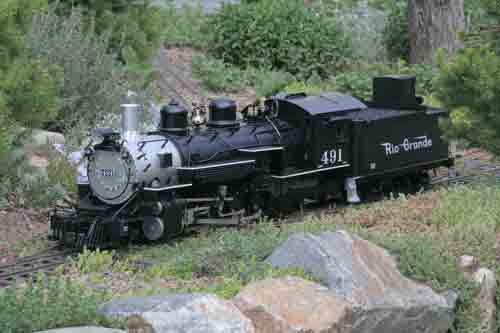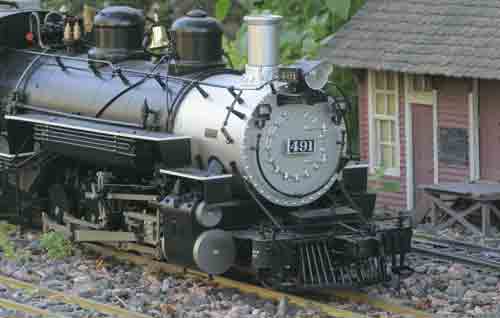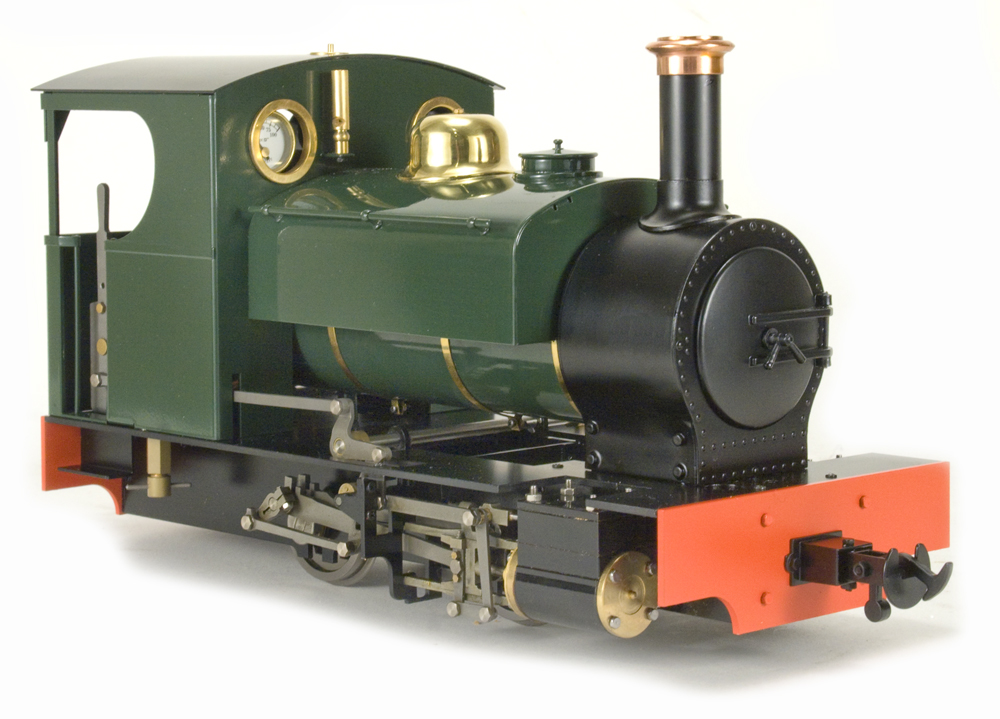1:20.3 scale, gauge 1,
ready-to-run 2-8-2
Accucraft Trains
33268 Central Ave.
Union City CA 94587
Price: $3,685
Web site: www.accucraft.com
Brass and steel model of the Denver & Rio Grande Western Railroad’s famous K-37 steam locomotive; electrically powered; minimum radius, 4′ (8′ diameter). Dimensions: length, 43″; width: 6.25″; height 8.25″. In 1:20.3, this works out to 72’9″ x 10’7″ x 13’11”, respectively. Weight, 28.5 lbs; tractive effort, 40 oz., or about 32 average freight cars on straight, level track
Pros: Accurately dimensioned model to published drawings; incredibly high level of detail; smooth, quiet operation; correct scale/gauge combination
Cons: Limited pulling capacity for a locomotive of its size; tender not free-rolling; some details difficult or impossible to install without modification; instructions for adding details need improvement
The locomotive comes in two boxes-the locomotive in one, the tender and sundry accessories in the second. These are both packed in one large shipping box lined with 2″ foam. The locomotive is cocooned in typical Accucraft fashion, secured to a plywood base that’s bolted to a metal case inside the box. The tender is packed in expanded Styrofoam.
Once I unpacked everything, I set about adding the various details that come with the engine. There is an “instruction sheet” supplied, though it’s instructional value is questionable. Pilot and trailing trucks were somewhat self-explanatory, but I would like to have seen clearer illustrations showing the arrangement of springs and washers. The sundry details that adorn the locomotive are more enigmatic. There’s one photo included, which shows where the safety valves, generator exhaust, and whistle are placed. Safety valves and generator exhaust are self-explanatory; the whistle, on the other hand, cannot be mounted on the locomotive without modifying the L-pipe to which (I assume) it is to be fastened. This L-pipe would intuitively get screwed into the side of the steam turret on top of the boiler, but the piece is too large to screw into the boiler without hitting it. I removed enough material to get it mostly threaded in, but the hole really should be drilled out and the part glued in place with epoxy.
There were no instructions showing where the snifting valves go, and their screw stems are longer than the holes in the cylinders, necessitating them to be trimmed so the valves screw all the way down. The holes in the re-railers that are supposed to hang from the tender don’t match the tender’s hooks, so they cannot be hung without modification, either.
Once the details are attached, however, the locomotive becomes quite the beauty queen. Accucraft did a great job including almost all of the subtle details of the prototype, including the metal bin on the side of the smokebox where flags were stored. In looking at photos and drawings of this locomotive, I could find nothing left off or compromised, although scholars of the D&RGW may find subtle variations that don’t precisely match the prototype. The tender trucks are even correct, with side frames set to standard-gauge width and wheels narrowed on the axle. The overall fit and finish of the locomotive is excellent. Lettering is crisp and accurate, and the paint is even.
All windows have glazing except the forward ones on the sides of the cab. I don’t know why Accucraft doesn’t include the glazing in those two windows.
Accucraft’s “new” couplers are included, although I don’t see a difference between them and the old ones. They operate smoothly and prototypically. The front coupler on my review sample was mounted higher than the one on the tender. Looking closer, I noticed the coupler pocket has two openings. The lower opening would put the coupler at the correct height. Again, comments relating to this (and how to change it) in the instructions would be welcome.
Operationally, the locomotive is a winner, if a bit light-footed. It creeps along at a snail’s pace at a mere 1.5V. Top speed at 20V is in the neighborhood of 40 scale miles per hour-about right for this engine. It is a fairly strong puller, but I would expect a locomotive of its size and weight to be far stronger. It produced 2.5 pounds of drawbar force; significantly less than the Accucraft Shay, which is 10 pounds lighter, and a mere four ounces more than Bachmann’s 2-8-0. Fortunately the boiler is completely empty and accessible through the smokebox door, so adding a plastic bag full of lead shot would be a simple modification.
The LED headlight comes on right before the locomotive starts to move. It’s directional, so the rear tender light comes on when running in reverse. Track pickup is via the locomotive and the tender wheels, with all wheels (except the pilot and trailing trucks) picking up power. The coal load in the tender is removable for access to the electronics and the cavernous space within. There’s plenty of room for batteries, sound system, a speaker, and any DCC or R/C throttle combo you would wish to install. The instruction manual includes a wiring diagram, so you can easily figure out which wires go to what.
The tender is perhaps the biggest hindrance to this locomotive’s performance. It’s a lead sled-anything but free rolling. The track pick ups Accucraft uses are horrid in terms of drag, even with conductive lubricants applied to them. I set the tender on a 4% grade and it didn’t move. The locomotive spends much of its tractive effort just pulling the tender. Accucraft makes ball-bearing wheelsets for power pickup. Why they don’t use those instead is beyond me. If you convert to battery power, then get rid of the power pickups and enjoy the immediate improvement
in performance.
Overall, I’m quite impressed with this locomotive. It’s a beauty in every sense of the word. It runs like a fine Swiss watch, setting a benchmark for performance that’s hard to beat. All the shortcomings mentioned above can easily be overcome by the modeler. If you’re a modeler with limited space, you may find this locomotive too large for your railroad. At 43″ long, it took up half of my sidings by itself. If your railroad is in a confined space, you may want to see the locomotive first before plunking down the cash.















